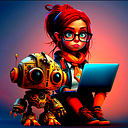Designing for AI: Human-Centered Approaches in the Age of Automation
✔ The Rise of AI in Design
Artificial Intelligence (AI) is rapidly transforming the landscape of design. From automated design tools to intelligent assistants, AI is reshaping how we create and interact with digital products. However, it’s crucial to remember that AI is a tool to enhance human creativity, not replace it.
Supporting Heart Area❤️
📚 The Role of Human-Centered Design
Even as AI becomes more sophisticated, the human element remains essential. Human-centered design principles ensure that AI-powered products are:
- User-Friendly: Easy to understand and navigate.
- Inclusive: Accessible to people of all abilities.
- Ethical: Respectful of user privacy and free from bias.
⚙️ Key Principles for AI-Driven Design
- Understand User Needs: Conduct thorough user research to identify pain points and opportunities.
- Prioritize Human Values: Design AI systems that align with human values and ethics.
- Transparent Design: Make AI systems transparent and explainable.
- Iterative Design: Continuously test and refine AI-powered designs.
- Ethical Considerations: Address potential biases and ethical implications of AI.
💻 Tools and Techniques for AI-Powered Design
- AI-Powered Design Tools: Use tools like Figma and Adobe XD to leverage AI for design automation and generation.
- Machine Learning: Apply machine learning algorithms to analyze user data and personalize experiences.
- Natural Language Processing (NLP): Design voice-activated interfaces and chatbots.
- User Testing: Conduct user testing to evaluate the effectiveness of AI-powered designs.
👩💻 The Future of Design
As AI continues to advance, designers will need to adapt to new challenges and opportunities. Some key trends to watch include:
- Hyper-Personalization: Tailoring experiences to individual users.
- Augmented Intelligence: Combining human and AI capabilities to enhance creativity and problem-solving.
- Ethical AI: Ensuring that AI is used responsibly and ethically.
💫 The Human Touch
While AI can automate many tasks, it cannot replace the creativity, empathy, and critical thinking skills of human designers. By combining the power of AI with human ingenuity, we can create truly innovative and user-centric products.
The future of design is exciting and full of possibilities. By embracing AI as a tool, rather than a replacement, we can shape a future where technology enhances human experiences.
If you found this article helpful, attractive, useful and would like to support me, make sure to:
Supporting Heart Area❤️
— — — — — — — — — — — — — — — — — — — — — — — — — — — — — — — — —
Authored by: [Niamh]
This collaborative research-driven exploration required [1] day of dedication and [2 to 3] hours of meticulous crafting.
Let’s get connected on Twitter: [@niamh_dcreator]
Thank you for your interest.
— — — — — — — — — — — — — — — — — — — — — — — — — — — — — — — — —
